Homepage
Click
here
for our
Fix Departures trips
in Garhwal Himalayas
Kuari
Pass  Khero Valley
Khero Valley  Chenap Bughyal
Chenap Bughyal  7 others...
7 others...
Nanda
Devi Sanctuary  Nanda
Devi Classic
Nanda
Devi Classic  Panch Kedar
Panch Kedar  Roopkund
Roopkund  and others...
and others...

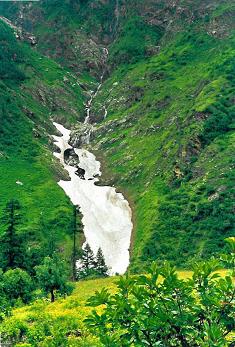
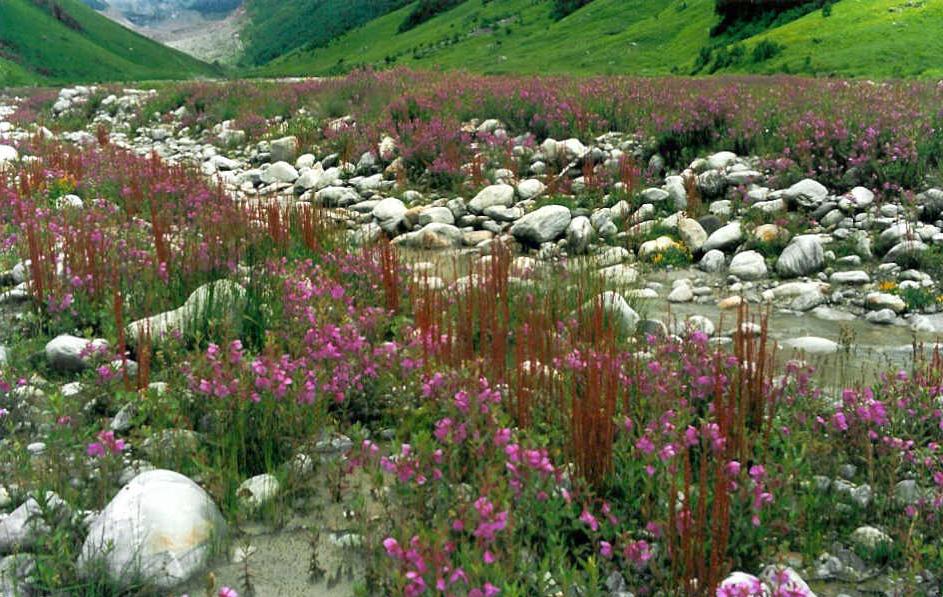
Ratan Vani Parvat, 6166m, from the Valley.
Valley Of
Flowers Trekking
...
The
world famous Valley of Flowers is situated in the upper expansions of
Bhyundar Ganga in the far interior of Garhwal Himalayas. The valley is spread
over an area of 87.5 Sq. Kms. and is 3,250 mts. to 6,750 mts. above mean sea
level. Rich references to this colouful and eye catching Valley, are found in
the annals of Indian History and literature such as the Ramayana and
Mahabharat.
The valley of Flowers National Park starts
from Ghangharia but the main valley starts after crossing the gorge and the
stream starting from Nar Parvat, 3 kms. from Ghangharia. In front of the Valley
stands the snowclad peak of Ratban Parvat and at the back is the Kunt Khal.
Towards the left is Nar Parvat, which separates the Badrinath valley from this
valley, and to the right is dense Birch forest on the hill sides.
Below the forest is the meadow. River
Pushpavati flows through the valley and there are many waterfalls enhancing the
beauty of the valley. The splendour and the scintillating beauty of the valley
attracts tourists from all over the world.
| The bloom starts immediately after the
melting of snow but the peak blooming period is from mid July to mid of
August. Almost 300 species of wild flowers bloom here in natural way.
Wherein some of the species areAnemone, Geranium, Marsh marigold, Prinula,
Potentilla, Geum, Asters, Lilium, Ranunculus, Corydalis, Inula, Braham
kamal, Campanula, Pedicularis, Arisaema, Morina, Impatiens, Bistorta,
Ligularia, Anaphalis, Saxifrages, Sibbaldia, |
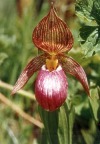 |
| Thermopsis, Trollius,
Codonopsis, Dactylorhiza, Cypripedium, Strawberry, Epilobium, Rhododendrons
and numerous others. Most of the flowers have medicinal values too. The
abundance of Asmanda fern in this valley is a rare sight than in other
Himalayan valleys. The valley remains is bloom for three months while the
looral composition keeps on changing every few days. By September the hue
starts changing and autumn bids farewell to flowers and the entire
vegetation remains dormant for about next five months when the valley is
snow bound. |
Apart from the flowers some species of
Butterfly, Musk deer, Blue sheep ( Bharal ), Himalayan bear, Himalayan
mouse hare and some Himalayan birds & Snow leopard are also found in this
area. Due to these specialities it has always caught the attention of the nature
lovers as well as the environmentalists. To conserve the nature’s benevolent
gift and to maintain the natural balance of the valley-the valley was declared a
National Park in 1982.
APPROACH :
The valley is approachable from Govindghat.
There are two ways to reach Govindghat.
-
Rishikesh-Srinagar-Karnprayag-Joshimath-Govindghat-(Distance approx. 270 Kms.
On Haridwar-Badrinath highway)
-
Haldwani-Ranikhet-Karnprayag-Joshimath-Govindghat (Distance approx. 332 Kms.)
After crossing the Alaknanda river at
Govindghat, an ascending bridle path along Bhyundar Ganga leads to Ghangharia
which is 13 kms. Away from Govindghat, from wher the Valley is only 3 kms.
GENERAL INFORMATION
:
Area :
87.5 Sq. Kms.
Location: On
the upper expansions of Bhyundar Ganga in Chamoli District of Uttar Pradesh.
Climate :
July and August
Maximum Temp.: 15 to 25 Celsius
Minimum Temp : -15 to 5 Celsius
Head Quarters :
Joshimath
Nearest Railway Station
: Rishikesh, Distt. Dehradun
Nearest Air Port :
Jolly Grant, Distt. Dehradun (17 Kms. From Rishikesh)
Nearest petrol pump :
Jharkula, Joshimath (22 kms. Before Govindghat)
Nearest
Hospital/Market/Bank : Joshimath
Nearest Post & Telegraph
Office/Phone : Govindghat
Best time to visit :
From mid July to mid of August
Days
|
Places
|
Remarks
|
Altitude
|
| 1
st |
Joshimath
- Govindghat by motor road
&
trek to Ghangaria.
Overnight
in camp. |
19
km
+
14 km trek.
8
hours |
1871
m. - 3049m. |
| 2
nd |
Ghangaria
- Valley of Flowers - Ghangaria.
Overnight
in camp. |
10
km.
8
hours. |
3049
m. – 3962 m. |
| 3
rd |
Ghangaria
– Hemkund Sahib - Ghangaria.
Overnight
in camp. |
12
km.
8
hours. |
3049
m. – 4329 m. |
| 4
th |
Ghangaria
– Govindghat
down
trek
&
motor road to Badrinath.
Overnight
in hotel. |
14
km trek
+
22 km.
8
hours. |
3049
m. – 3150 m. |
| 5
th |
Sightseeing
of Badrinath – trek to Mana - and drive back to Joshimath.
Overnight
in Hotel. |
3
km trek
+
35 km.
9
hours. |
3150
m. - 1871 m. |
Cost:
Rs.20,000 per person
(for group of
2 pax )
4.08%
government service tax and permits fees extra.
COSTS include:
Road transportation from Rishikesh to Rishikesh by car, Accommodation in Medium
Class Hotels (where applicable) on a twin sharing basis, all Meals, tents on
twin share basis, cooking tent and utensils, table and chairs, permits and
entrance fees, English speaking guide, cooks and porters/mules. We serve variety
of food on our trips which includes Indian, western and Chinese.
COSTS exclude:
Accommodation in Rishikesh, Personal Insurance, all alcoholic beverages and
Expenses of personal nature.
The
Valley of flowers
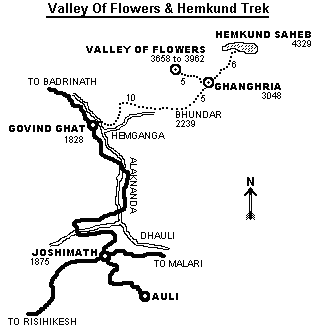 The
valley was 'discovered' by the british mountaineer Frank Smythe in 1931 after
a successful climb on Kamet peak. The team crossed the Bhyundar Pass in the
lashing rain and mist, intent on forging a new route through the mountains
back to Joshimath. As they descended into the shelter of the valley, the clouds
lifted and revealed alpine meadows carpeted with wildflowers. They were greeted
with the sight of primula, saxifrage, red potentillas, geraniums, asters,
gentians, anemones, delphiniums, blue corydalis and wild roses. The many hundreds
of flowering species lead Smythe to refer to the Bhyundar Valley
as the 'valley of flowers'.
The
valley was 'discovered' by the british mountaineer Frank Smythe in 1931 after
a successful climb on Kamet peak. The team crossed the Bhyundar Pass in the
lashing rain and mist, intent on forging a new route through the mountains
back to Joshimath. As they descended into the shelter of the valley, the clouds
lifted and revealed alpine meadows carpeted with wildflowers. They were greeted
with the sight of primula, saxifrage, red potentillas, geraniums, asters,
gentians, anemones, delphiniums, blue corydalis and wild roses. The many hundreds
of flowering species lead Smythe to refer to the Bhyundar Valley
as the 'valley of flowers'.
Reprints
of Frank Smythe's book The Valley of Flowers
can be found in Delhi.
The
valley is 10 km long and 2 km wide, and is divided by the Pushpawati stream,
into wich several tiny streams and waterfalls merge.
Hemkund
Sahib
From
Ghangaria, it is possible to follow the Laxma Ganga to the lake at Hemkund
(4329m). In the Sikh holy book Dasam Granth,
the Sikh guru Gobind Singh recounts that in a previous life he meditated on
the shores of a lake surrounded by seven snow-capped mountains. In 1930, a
teacher from a Sikh religious center recognised this lake as Hemkund.
As the valley of flowers has been an attraction for botanists worldwide since
1930's, Hemkund has become a main pilgrimage for Sikhs. Most pilgrims wash
themselves in the icy waters of the lake before visiting the gurdwara, built
around 20 years ago next to the lake.
Badrinath
and Mana
Badrinath
is a Hindu holy center (dham) as Yamunotri, Gangotri and Kedarnath in the
area,
lying
beneath the snow-capped peak of Nilkantha (6957m).
About
3 km north of the village is the small Bhotia settlement of Mana,
the
last village before the Tibetan border, just over 30 km away.
It
was before an important trading village between India and Tibet.
During
winter, the villagers retreat from the heavy snows to Joshimath and Chamoli.
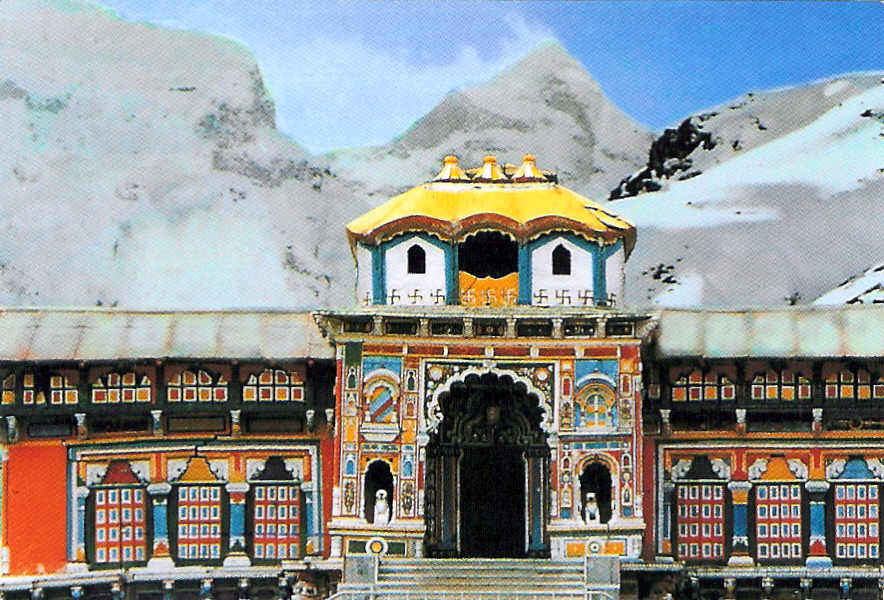
Hindu
temple at Badrinath (3150m)
back
For us being reliable is way of life !!
Every
Journey
Should
Inspire
You
And
Fire
Your
Passion
For Travel
&
Discovery...............
For Further Details
Contact us :

Adventures
Trekking LTD
:


sitemap sitemap2 sitemap3 site1 site2 site3 site4 site5 site6 site6
![]() Trekking
Trekking
![]() Biking
Biking
![]() Rafting
Rafting ![]() Camping
Camping
![]() Climbing
Climbing
![]() Skiing
_________________________________________________________________________________________
Skiing
_________________________________________________________________________________________



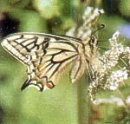

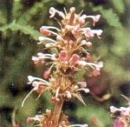
 The
valley was 'discovered' by the british mountaineer Frank Smythe in 1931 after
a successful climb on Kamet peak. The team crossed the Bhyundar Pass in the
lashing rain and mist, intent on forging a new route through the mountains
back to Joshimath. As they descended into the shelter of the valley, the clouds
lifted and revealed alpine meadows carpeted with wildflowers. They were greeted
with the sight of primula, saxifrage, red potentillas, geraniums, asters,
gentians, anemones, delphiniums, blue corydalis and wild roses. The many hundreds
of flowering species lead Smythe to refer to the Bhyundar Valley
as the 'valley of flowers'.
The
valley was 'discovered' by the british mountaineer Frank Smythe in 1931 after
a successful climb on Kamet peak. The team crossed the Bhyundar Pass in the
lashing rain and mist, intent on forging a new route through the mountains
back to Joshimath. As they descended into the shelter of the valley, the clouds
lifted and revealed alpine meadows carpeted with wildflowers. They were greeted
with the sight of primula, saxifrage, red potentillas, geraniums, asters,
gentians, anemones, delphiniums, blue corydalis and wild roses. The many hundreds
of flowering species lead Smythe to refer to the Bhyundar Valley
as the 'valley of flowers'.